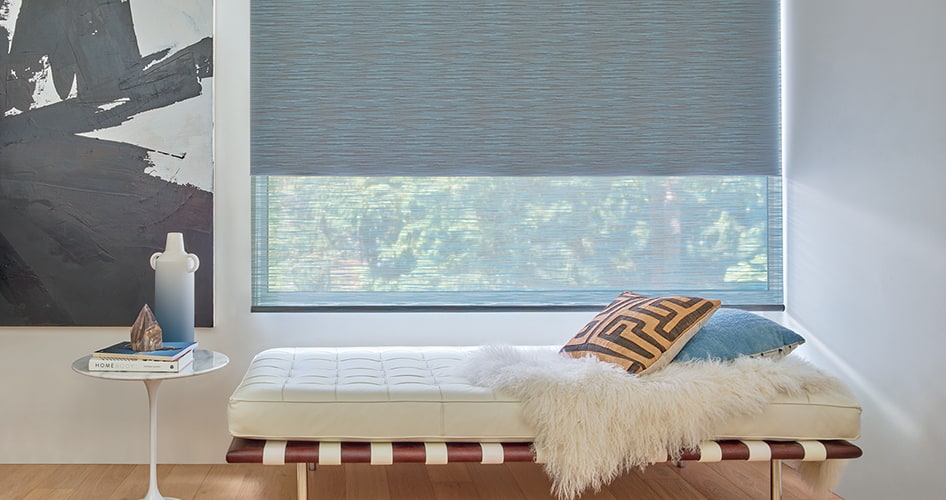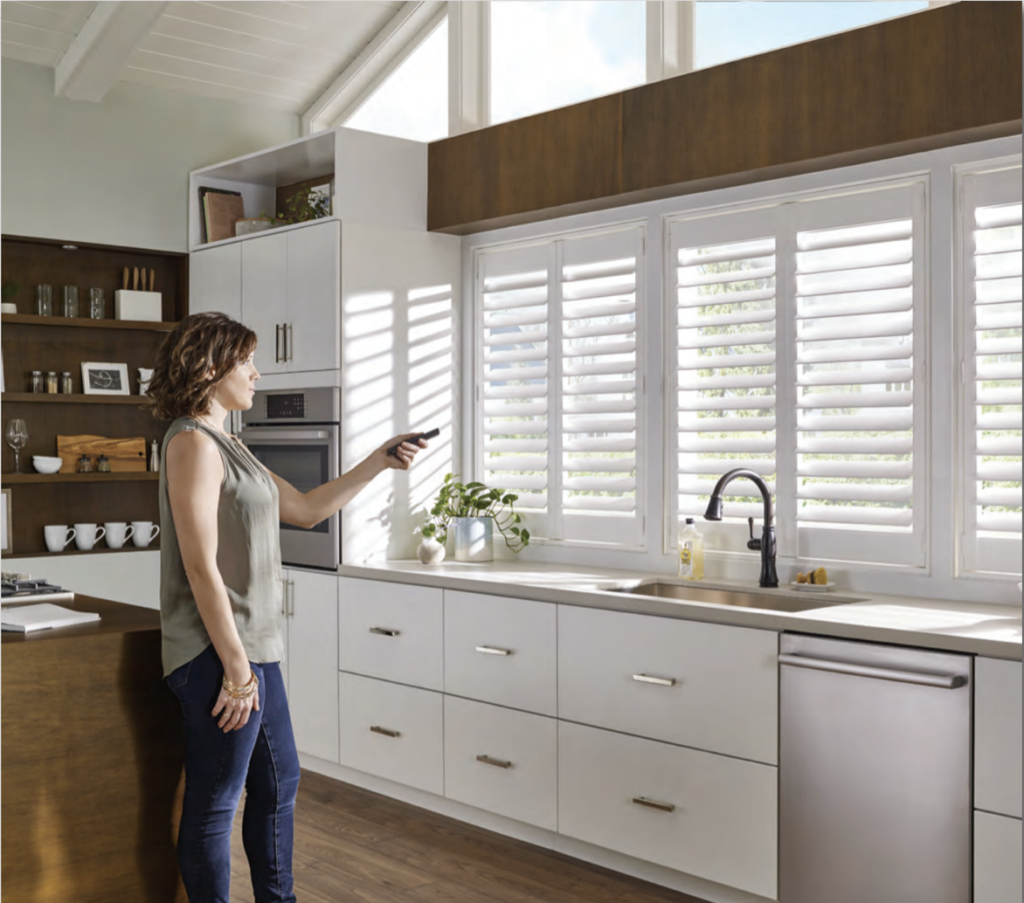Create A Comfortable & Modern Space In Your Bedroom
Your bedroom should be a serene space that you can relax in, any way you’d like.
Adding blinds to your space can add privacy, allow you to darken or lighten the room depending on your needs, and add a modern touch to one of the most important places in your home.
At Sun Shades Window Fashions, we have a number of unique and custom options at each of our locations across the GTA that will elevate any bedroom, making it your new favourite room to relax in.
Roller Shades
Roller Shades are timeless. Each shade is precision-engineered for a silent, smooth operation with minimal light gap, providing extra privacy for your space.
Hunter Douglas
Upgrade your space with custom treatments to make your house a home. Enjoy choices at Hunter Douglas that you won’t find anywhere else.
Honeycomb Shades
Specially engineered to provide energy efficiency at the window in both cold and warm climates.
Custom Window Treatments For Bathrooms
You know what you want.
We make it happen
Talk to our team of experts by calling us at
(289) 275-6630. Enhance your home with exquisite window treatment decor.
We design
we measure
we install
you relax
Let's realize your vision.
Start with a free quote
Are you ready to elevate your bedroom with new window treatments? Give us a call to set up a free consultation with one of our experts in the GTA!
Check Out Our Frequently Asked Questions About Our Products!
Fully Lift the blinds to ensure they are not under tension. Locate the brackets holding the blinds in place. These are typically located at the top of the blinds near the window frame. Depending on the type of brackets, there may be a latch securing the blinds in place. Release the latch to loosen the brackets. Once the brackets are loosened, carefully lift the blinds upward to release them from the brackets.
- Dusting: Start by dusting the blinds regularly with a feather duster, microfiber cloth, or a vacuum cleaner with a soft brush attachment. This helps remove loose dirt and debris.
- Spot Cleaning: For spots or stains, use a mild detergent mixed with warm water. Dampen a clean cloth with the solution and gently blot the affected area. Avoid rubbing vigorously to prevent damaging the fabric.
- Deep Cleaning: For deeper cleaning, you can remove the blinds from the window (following the instructions provided by Hunter Douglas) and soak them in a bathtub filled with warm water and mild detergent. Let them soak for a few minutes, then gently scrub with a soft brush or sponge. Rinse thoroughly with clean water and allow them to air dry completely before reinstalling.
- Ultrasonic Cleaning: Some Hunter Douglas blinds can be safely cleaned using ultrasonic cleaning machines available at professional blind cleaning services. These machines use sound waves to remove dirt and grime from the blinds without causing damage.
Always check the care instructions provided by Hunter Douglas for your specific type of blinds, as cleaning methods may vary depending on the material and design. Avoid using harsh chemicals or abrasive cleaners, as they can damage the blinds’ finish or fabric.
Hunter Douglas offers a limited lifetime warranty on many of their products, including certain blinds and shades. However, the specifics of the warranty can vary depending on the product line and the region in which it was purchased.
It’s essential to review the warranty information provided with your specific Hunter Douglas blinds or shades to understand what is covered and for how long. Typically, the warranty covers defects in materials and workmanship for the lifetime of the product under normal use and conditions. For accurate and up-to-date information regarding the warranty coverage for your Hunter Douglas blinds, I recommend contacting Hunter Douglas customer service or visiting their official website.
- Secure Installation: Ensure that the outdoor shades are securely installed using appropriate hardware and fasteners. Make sure the brackets or mounting hardware are firmly attached to the structure.
- Tensioning Devices: Some outdoor shades come with built-in tensioning devices or tie-downs that help keep them in place during windy conditions. Utilize these features if available to secure the shades against strong winds.
- Wind Clips or Straps: Install wind clips or straps to secure the bottom of the shades to a stable structure, such as a railing or post. These clips or straps help prevent the shades from flapping in the wind.
- Weighted Bottom Bars: Consider using weighted bottom bars or hem bars on the shades to provide additional stability and prevent them from being lifted by the wind. These bars help anchor the shades in place, especially during windy weather.
- Retract or Roll Up: If strong winds are forecasted, consider retracting or rolling up the outdoor shades to prevent damage. Many outdoor shades are designed to be easily rolled up or retracted when not in use, providing protection from windy conditions.
- Regular Maintenance: Keep the outdoor shades clean and well-maintained to ensure proper function and longevity. Inspect the shades periodically for any signs of wear or damage, and address any issues promptly to prevent them from becoming a problem during windy weather.
By implementing these measures, you can help keep your outdoor shades secure and stable during windy conditions, minimizing the risk of damage or displacement.
Yes, motorized blinds can be battery-operated. Many motorized blinds offer the option to power the motors with batteries instead of relying on a wired electrical connection. This provides flexibility in installation and allows for wireless operation, which can be convenient and aesthetically pleasing.
Currently most battery operated blinds are rechargeable however they can also require batteries depending on the motorized blinds system you choose. It’s essential to check the manufacturer’s specifications and instructions for proper battery selection and installation.
Yes, most existing blinds can often be motorized with retrofit kits or motorization solutions offered by various manufacturers. These motorization kits typically include a motor that can be installed discreetly within the headrail of the blinds, as well as a control mechanism such as a remote control or smartphone app.
The process of motorizing existing blinds may vary depending on the type and brand of blinds you have, as well as the specific motorization kit you choose. In some cases, it may require professional installation, especially if you’re not comfortable with DIY projects or if the blinds are complex.
Before purchasing a motorization kit, it’s essential to ensure compatibility with your existing blinds and to review the installation instructions provided by the manufacturer. Additionally, consider factors such as power source (battery-operated vs. wired), control options, and any additional features you may want, such as integration with smart home systems.
1. **Operation**: Blinds typically have slats that can be tilted open or closed to control light and privacy, while shades are made of a single piece of material that can be raised or lowered.
2. **Material**: Blinds are often made of hard materials like wood, metal, or vinyl, whereas shades are typically made of softer materials like fabric or woven bamboo.
3. **Light Control**: Blinds offer more precise control over light and privacy due to their adjustable slats, while shades provide varying degrees of light filtration or blackout depending on the material.
4. **Aesthetics**: Blinds offer a more structured and architectural look, while shades tend to have a softer, more fabric-like appearance.
5. **Installation**: Blinds are usually mounted inside the window frame or on the outside, while shades can be mounted inside, outside, or even ceiling-mounted depending on the type.
Ultimately, the choice between shades and blinds depends on factors such as personal preference, desired functionality, and the aesthetic of the space.
1. **Width Measurement**:
– Measure the width of the window frame at three points: the top, middle, and bottom.
– Record the narrowest width measurement. This ensures that the blinds will fit within the window frame without rubbing against the sides.
2. **Height Measurement**:
– Measure the height of the window frame at three points: left, center, and right.
– Record the longest height measurement. This ensures that the blinds will fully cover the window opening when lowered.
3. **Depth Measurement** (if installing inside the window frame):
– Measure the depth of the window frame from the inside surface to any obstacles such as handles or locks.
– This measurement ensures that there is enough space to mount the blinds inside the window frame without obstruction.
4. **Considerations**:
– Decide whether you want the blinds to be mounted inside or outside the window frame. Inside mount provides a cleaner look, while outside mount offers better light control and privacy.
– If opting for an outside mount, add extra width and height to ensure full coverage and overlap of the window frame.
5. **Note Down Measurements**:
– Write down the width, height, and depth measurements, along with whether the blinds will be mounted inside or outside the window frame.
6. **Double Check**:
– Always double-check your measurements to ensure accuracy before purchasing blinds.
When ordering blinds, provide the measurements to the manufacturer or retailer to ensure that you receive the correct size. Some manufacturers may have specific instructions for measuring, so it’s a good idea to check their guidelines as well.
Whether window treatments should be the same throughout the house depends on personal preference, the overall design aesthetic, and the functional needs of each room. Here are some factors to consider when deciding whether to use the same window treatments throughout the house:
1. **Consistency**: Using the same window treatments throughout the house can create a cohesive look and flow from room to room, especially in open-concept spaces or areas with sightlines between rooms.
2. **Aesthetic**: Consider the overall style and decor of your home. While matching window treatments can provide consistency, mixing and matching styles or materials can add visual interest and character to different rooms.
3. **Functionality**: The function of each room may influence the type of window treatments needed. For example, bedrooms may require blackout shades for better sleep, while living areas may benefit from sheer curtains for diffused light.
4. **Privacy and Light Control**: Evaluate the privacy and light control needs of each room. Rooms facing different directions or with varying levels of natural light may require different types of window treatments.
5. **Room Size and Layout**: Consider the size and layout of each room. Large, spacious rooms may require different window treatments than smaller, cozier spaces to maintain proportion and balance.
6. **Budget**: Budget considerations may also play a role. Using the same window treatments throughout the house can be cost-effective, but investing in custom treatments for specific rooms may better suit individual needs and preferences.
Ultimately, there are no hard and fast rules, and the decision to use the same or different window treatments throughout the house is a matter of personal preference and practical considerations. Experiment with different options to find what works best for your home and lifestyle.




